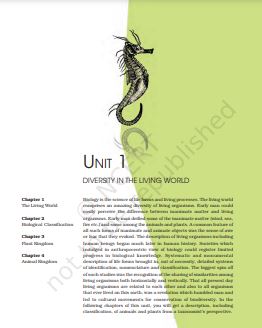‘NCERT Solutions for Class 11 Biology Chapter 1‘ PDF Quick download link is given at the bottom of this article. You can see the PDF demo, size of the PDF, page numbers, and direct download Free PDF of ‘Ncert Class 11 Biology Chapter 1 Exercise Solution’ using the download button.
NCERT Class 11 Biology Textbook Chapter 1 With Answer PDF Free Download

Chapter 1: The Living World
Biology is the science of life forms and living processes. The living world comprises an amazing diversity of living organisms.
Early man could easily perceive the difference between inanimate matter and living organisms. Early man deified some of the inanimate matter (wind, sea, fire, etc.) and some among the animals and plants.
A common feature of all such forms of inanimate and animate objects was the sense of awe
or fear that they evoked.
The description of living organisms including human beings began much later in human history.
Societies that indulged in an anthropocentric view of biology could register limited progress in biological knowledge.
Systematic and monumental description of life forms brought in, out of necessity, detailed systems of identification, nomenclature, and classification.
The biggest spin-off of such studies was the recognition of the sharing of similarities among living organisms both horizontally and vertically.
That all present-day living organisms are related to each other and also to all organisms that ever lived on this earth, was a revelation that humbled man and led to cultural movements for the conservation of biodiversity.
In the following chapters of this unit, you will get a description, including the classification, of animals and plants from a taxonomist’s perspective.
How wonderful is the living world! The wide range of living types is amazing.
The extraordinary habitats in which we find living organisms, be it cold mountains, deciduous forests, oceans, freshwater lakes, deserts, or hot springs, leave us speechless.
The beauty of a galloping horse, the migrating birds, the valley of flowers, or the attacking shark evokes awe and a deep sense of wonder.
The ecological conflict and cooperation among members of a population and among populations of a community or even the molecular traffic inside a cell make us deeply reflect on – what indeed is life?
This question has two implicit questions within it.
The first is a technical one and seeks an answer to what living is as opposed to non-living, and the second is a philosophical one and seeks an answer to what the purpose of life is.
As scientists, we shall not attempt to answer the second question. We will try to reflect on – what is living?
1.1 What is ‘Living’?
When we try to define ‘living’, we conventionally look for distinctive characteristics exhibited by living organisms.
Growth, reproduction, ability to sense the environment and mount a suitable response come to our mind immediately as unique features of living organisms.
One can add a few more features like metabolism, ability to self-replicate, self-organize,
interact, and emergence to this list.
Let us try to understand each of these. All living organisms grow.
An increase in mass and an increase in the number of individuals are twin characteristics of growth. A multicellular organism grows by cell division.
| Author | NCERT |
| Language | English |
| No. of Pages | 15 |
| PDF Size | 1.4 MB |
| Category | Biology |
| Source/Credits | ncert.nic.in |
NCERT Solutions Class 11 Biology Chapter 1 The Living World
1. Why are living organisms classified?
Solution:
The earth contains millions of organisms, and we may know the plants and animals that live near us by their native names. These local names vary from place to place within a country.
This leads to confusion in identifying and studying specific species. Therefore, it must be called by common name throughout the world to standardize the nomenclature and study of organisms.
To achieve this, organisms are named and categorized according to their roles.
2. Why are the classification systems changing every now and then?
Solution:
Scientific study is ever a work in progress and new species and organisms are often added. The initial system of classification focuses only on the habits and habitat of organisms.
Gradually external morphology became a toll on classification. After this, the morphology and embryology are taken into account, followed by the phylogenetic relationship, and the cytology of the organism.
Modern-day uses biochemical techniques to classify organisms based on their nucleic acid components.
3. What different criteria would you choose to classify people that you meet often?
Solution:
The people we meet most often are categorized by characteristics such as gender, skin color, education, career, hobbies, and nature.
4. What do we learn from the identification of individuals and populations?
Solution:
By identifying individuals and populations, we learn the following things
(i) Sex
(ii) Skin color
(iii) Native place
(iv) Mother tongue
(v) Food habit
(vi) Religion
(vii) Caste
5. Given below is the scientific name of Mango. Identify the correctly written name.
Mangifera Indica
Mangifera indica
Solution:
The answer is Mangifera indica. Here Mangifera is its genus name, and Indiaca is its species name which is always written in lowercase.
The Living World NCERT Textbook With Solutions PDF Free Download
